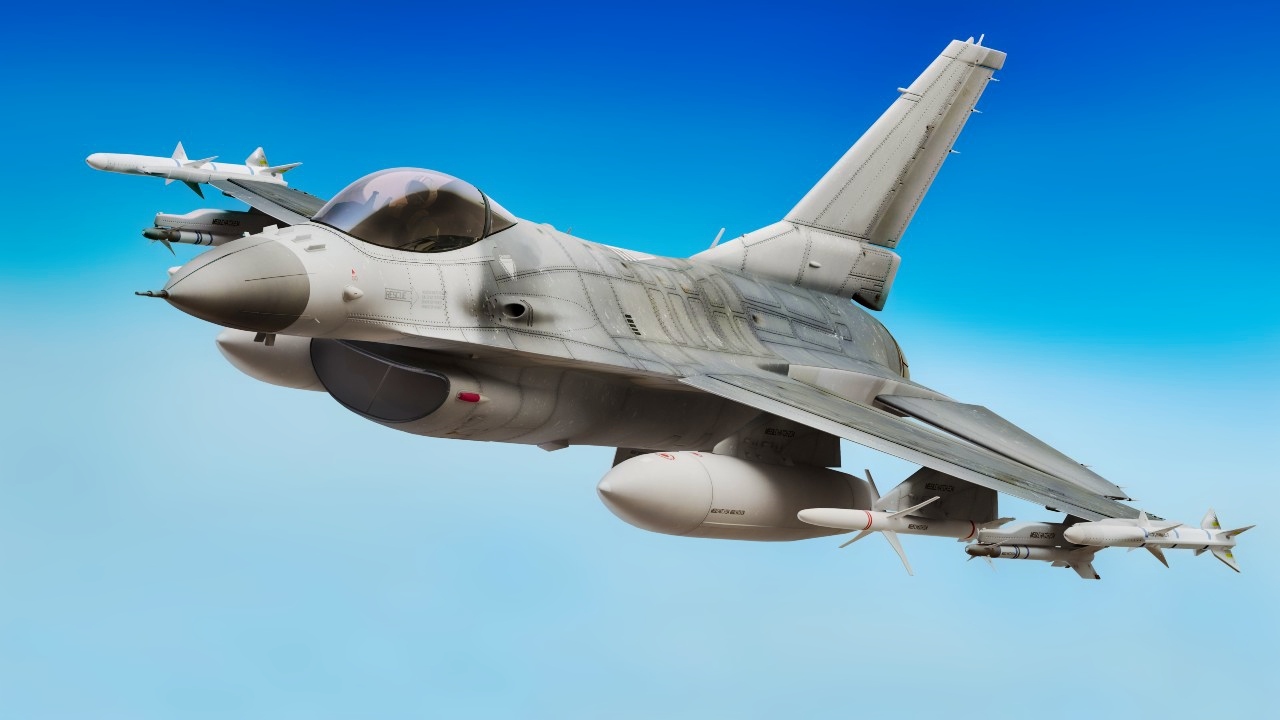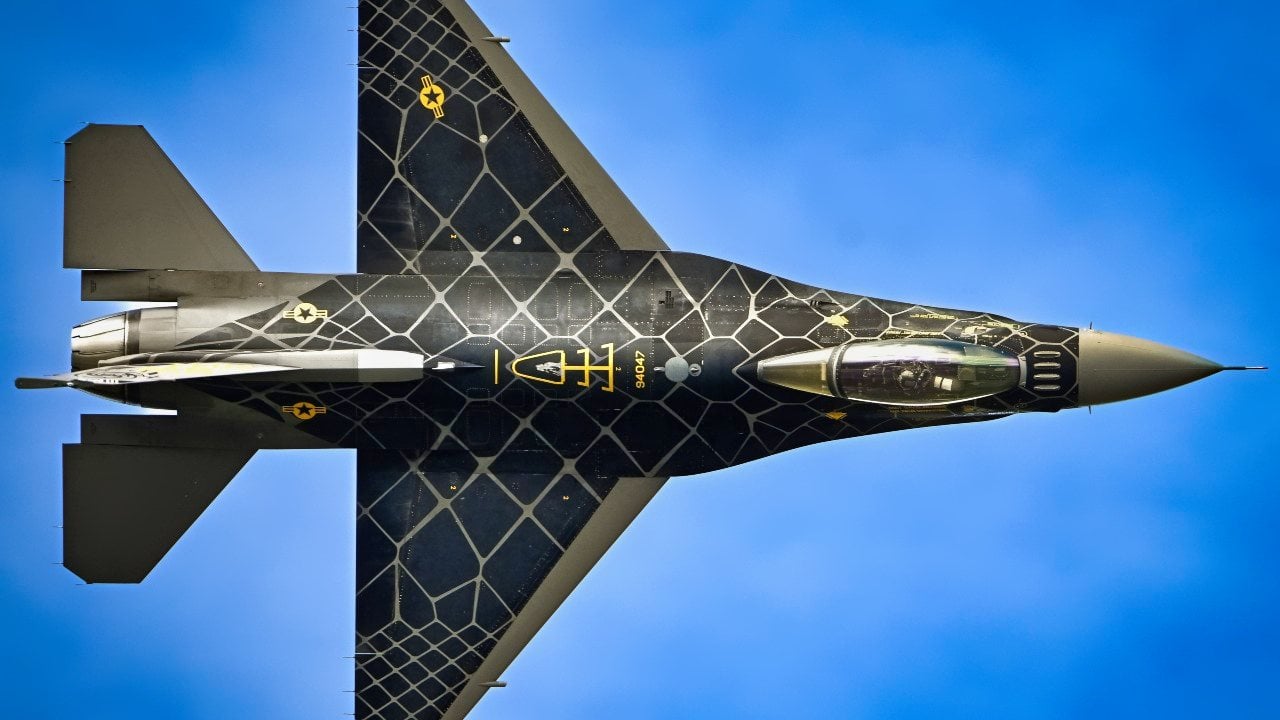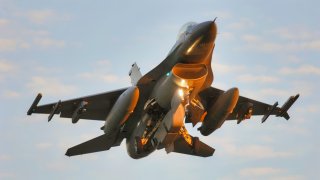The F-16 Fighter Has a Small Flaw That is Finally Being Fixed
The U.S. Air Force's F-16 Fighting Falcon, a global mainstay in air superiority for over 50 years, has always lacked a built-in boarding ladder, limiting operations in austere settings. This design choice, driven by the famed "Fighter Mafia" to reduce weight, left pilots reliant on pre-positioned ladders.
What You Need to Know: The U.S. Air Force's F-16 Fighting Falcon, a global mainstay in air superiority for over 50 years, has always lacked a built-in boarding ladder, limiting operations in austere settings. This design choice, driven by the famed "Fighter Mafia" to reduce weight, left pilots reliant on pre-positioned ladders.

Recently, Major Nicholas "Trapper" Atkins devised the Agile Combat Employment Ladder, a six-pound, foldable ladder that fits in the cockpit's map case, winning the 2024 Spark Tank competition.
This innovation could soon allow F-16 pilots easier access to their aircraft without compromising the fighter’s design priorities.
F-16's New Ladder Innovation Could Change Pilot Access for Good
The United States Air Force's F-16 Fighting Falcon first took flight more than 50 years ago, and it has been employed in operations around the globe. It has proven to be nearly unstoppable in the air, seeing service with dozens of allied and partner nations.
Yet, operators may be quick to point out it has one notable flaw – one that is part of its original design. Climbing into the Fighting Falcon isn't all that easy, as it lacks a built-in boarding ladder. That has limited where it can operate and how pilots are able to get into the cockpit. While other fighters were designed to land and be serviced from austere locations with limited support, this hasn't been the case for the F-16.
However, one innovative pilot has worked on a solution – and soon the Air Force could add a portable boarding ladder to the F-16.
Climbing the Ladder – And the "Fighter Mafia"
So why doesn't the Fighting Falcon have a ladder? The answer is well-established, and has to do with the thinking of the now infamous " Fighter Mafia."
In the mid-1960s, a small group of U.S. Air Force officers and civilian defense analysts – later to be dubbed the Fighter Mafia – oversaw the creation of a report calling for new fighter designs. The program evolved from lessons learned during the Vietnam War. That led to the development of the service's "teen series" of fighters.
While the F-15 Eagle was eventually equipped with a built-in ladder, such wasn't the case with the F-16. It was part of an effort of U.S. Air Force fighter pilot and later Pentagon consultant Col. John Boyd, who sought to cut the weight from the aircraft. It limited where the F-16 could operate, but Boyd had a solution, Air & Space Forces magazine reported.

"Tell them to get some goddamn orange crates and climb on those," Boyd said, according to a 2002 biography written by Robert Coram.
There were likely occasions where pilots climbed on crates, most of the time aviators relied on prepositioned ladders.
Enter the Agile Combat Employment Ladder
While Boyd sought to cut the weight of the F-16, Major Nicholas "Trapper" Atkins of the Air Force's 31st Fighter Wing apparently tired of having to wait for the ladder or carefully skirting the fuselage and jumping out of his aircraft.
Last year, he was part of a team that took part in a "Spark Tank" competition at Aviano Air Base, Italy. Inspired by TV's Shark Tank, the Air Force competition has encouraged units from around the world to hold innovation challenges where officers and enlisted airmen can provide ideas that improve operational effectiveness, but also reduce operating costs.
The Agile Combat Employment Ladder, which was profiled by The War Zone in September 2023, was reported to weigh just six pounds, while it cost $1,800. That included $1,500 in labor and $300 in materials – far less than the $5,200 cost for external ladders.
More importantly, the ladder was designed to fold and fit inside the aircraft's cockpit map case, which is largely no longer used as electronic devices like tablets have replaced the old-school paper maps and booklets that pilots would carry.
The ladder didn't just impress the brass at the base in Italy; it was one of six innovation proposals selected from 138 entries to be presented and judged at the Pentagon!

Last month, the prototype emerged as the 2024 Spark Tank winner, "allowing commanders the flexibility to dynamically deploy and redeploy the jets to or from austere locations," the Air Force announced.
"If you look at what our competitive advantage is going to be to get after the threat, it's our allies, it's our industry, and it's our people – our people are the ones innovating and bringing forward smart ideas," said Vice Chief of Space Operations Gen. Mike Guetlein, one of the Spark Tank judges.
While winning doesn't guarantee the Air Force will move forward with developing the ladder – or that it will ever be mass produced – it could help connect the finalists and semifinalists from the Spark Tank competition with the service's innovation groups, including AFWERX as well as industry.
By all accounts, it does seem that soon F-16 pilots could find it a little easier to enter and exit the cockpit, and to do so without adding the weight that Col. Boyd so wanted to see cut from the aircraft. The Fighting Falcon will remain a lean warbird, but just a bit easier to access.
Author Experience and Expertise: Peter Suciu
Peter Suciu is a Michigan-based writer. He has contributed to more than four dozen magazines, newspapers, and websites with over 3,200 published pieces over a twenty-year career in journalism. He regularly writes about military hardware, firearms history, cybersecurity, politics, and international affairs. Peter is also a Contributing Writer for Forbes and Clearance Jobs. You can follow him on Twitter: @PeterSuciu. You can email the author: [email protected].
Image Credit: Creative Commons and/or Shutterstock.
From the Vault


